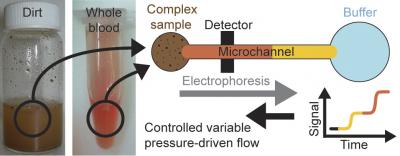Researchers at the National Institute of Standards and Technology (NIST) and Applied Research Associates have demonstrated the application of their innovative microfluidic system to examine the chemical elements of complex samples.
The researchers have utilized a method called gradient elution moving boundary electrophoresis (GEMBE) for studying the complex samples. The novel microfluidic system integrates a basic microfluidic structure, pressure-driven flow and electrophoresis. The basic microfluidic structure includes two reservoirs linked with a microchannel and electrophoresis makes use of electricity to transfer sample components via the fluid.
 llustration of a GEMBE device
llustration of a GEMBE device
Testing complex samples could be tough, since components of complex samples could pollute microfluidic channels. The conventional method requires the removal of contaminants using expensive, time-consuming sample making processes before analysis.
GEMBE resolves this issue by pushing fluid via the microchannel utilizing a harnessed pressure in the opposite direction to electrophoresis. This opposite pressure-driven flow functions as a ‘fluid gate’ between the microchannel and the sample reservoir. The fluid gate can be opened slightly by progressively decreasing the counter-flow pressure. Identification of specific sample constituents are possible when the pressure-driven flow weakens due to wide opening of the fluid gate resulting in the electrophoretic motion of the constituent forcing it against the pressure flow and into the channel for identification.
In this manner, various components of the complex sample go through the channel at various times depending on their specific electrophoretic motion. The microchannel does not taint, as unnecessary components in the sample are stopped. Elizabeth Strychalski, a researcher at the NIST, stated that this was attained by selecting a solution with a different pH to alter the electrophoretic motion of the unnecessary components. In other samples, this was achieved by adding commercial surface coatings to the complex sample, she said. The research team intends to optimize the GEMBE system by detecting exact surface coatings that enhance the technique for particular components in several complex samples.